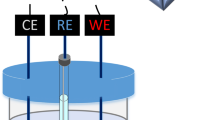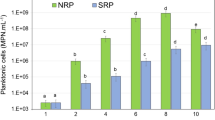Abstract
The bacterial biofilms formed on metal surfaces play an important role in the corrosion of the metal. Biofilm detachment can greatly influence the corrosion rate. Since the biofilms formed by certain strains of Serratia marcescens are known to get sloughed after prolonged surface exposure, studying the effect of corrosion media on this phenomenon and the corrosion rate will help in understanding the corrosion mechanism of S. marcescens. In this work, carbon steel was exposed to multiple systems containing S. marcescens isolated from treated river water used as a coolant in an oil refinery, referred to as industrial water (IW). The bacterial cultures were anaerobically cultivated in the American Petroleum Institute (API) growth medium and identified using 16S rRNA gene sequencing. Biofilm morphology was assessed through Light microscopy and Confocal Laser Scanning Microscopy (CLSM). The conditions required for biofilm sloughing were investigated by electrochemical impedance spectroscopy (EIS), potentiodynamic polarization, weight loss and surface morphological studies in four different media. While sterilized IW served as a control, biofilm detachment occurred during polarization studies only in the system where the metal sample was exposed to IW containing S. marcescens and the API medium. However, detachment did not occur during other analyses and in similar systems without the API medium or when nitrate ions were added to the API medium. Based on these observations, the mechanism adopted by S. marcescens for its growth and the corrosion of carbon steel under various conditions could be elucidated.











Similar content being viewed by others
Data Availability
Not applicable.
References
Lou Y, Chang W, Cui T et al (2021) Microbiologically influenced corrosion inhibition mechanisms in corrosion protection: a review. Bioelectrochemistry 141:107883. https://doi.org/10.1016/j.bioelechem.2021.107883
George RP, Muraleedharan P, Sreekumari KR et al (2003) Influence of surface characteristics and microstructure on adhesion of bacterial cells onto a type 304 stainless steel. Biofouling 19(1):1–8. https://doi.org/10.1080/08927010290031017
George R, Muraleedharan P, Parvathavarthini N et al (2000) Microbiologically influenced corrosion of AISI type 304 stainless steels under fresh water biofilms. Mater Corros 51:213–218. https://doi.org/10.1002/(SICI)1521-4176(200004)51:4<213::AID-MACO213>3.0.CO;2-J
Gubner R, Beech IB (2000) The effect of extracellular polymeric substances on the attachment of pseudomonas NCIMB 2021 to AISI 304 and 316 stainless steel. Biofouling 15(1–3):25–36. https://doi.org/10.1080/08927010009386295
Lv M, Du M (2018) A review: microbiologically influenced corrosion and the effect of cathodic polarization on typical bacteria. Rev Environ Sci Bio/Technol 17(3):431–446. https://doi.org/10.1007/s11157-018-9473-2
Natarajan K (2013) Biofouling and microbially influenced corrosion of stainless steels. In: A century of stainless steels, advanced materials research, vol 794. Trans Tech Publications, Bäch, pp 539–555. https://doi.org/10.4028/www.scientific.net/AMR.794.539
Cote C, Rosas O, Sztyler M et al (2014) Corrosion of low carbon steel by microorganisms from the ‘pigging’ operation debris in water injection pipelines. Bioelectrochemistry 97:97–109. https://doi.org/10.1016/j.bioelechem.2013.11.001
Beech I, Gaylarde CC (1999) Recent advances in the study of biocorrosion: an overview. Rev Microbiol 30:117–190. https://doi.org/10.1590/S0001-37141999000300001
Lee W, Lewandowski Z, Nielsen PH et al (1995) Role of sulfate-reducing bacteria in corrosion of mild steel: a review. Biofouling 8(3):165–194. https://doi.org/10.1080/08927019509378271
Little BJ, Ray RI, Pope RK (2000) Relationship between corrosion and the biological sulfur cycle: a review. Corrosion 56(4):433–443. https://doi.org/10.5006/1.3280548
Jia R, Yang D, Xu J et al (2017) Microbiologically influenced corrosion of c1018 carbon steel by nitrate reducing pseudomonas aeruginosa biofilm under organic carbon starvation. Corros Sci 127:1–9. https://doi.org/10.1016/j.corsci.2017.08.007
Chamritski IG, Burns GR, Webster BJ et al (2004) Effect of iron-oxidizing bacteria on pitting of stainless steel. Corrosion 60(7):658–669. https://doi.org/10.5006/1.3287842
Pitonzo BJ, Castro P, Amy PS et al (2004) Microbiologically influenced corrosion capability of bacteria isolated from Yucca Mountain. Corrosion 60(1):64–74. https://doi.org/10.5006/1.3299233
Castro P, Amy P, Jones D, et al (2004) Effect of rock surfaces on the corrosion capability of Yucca Mountain bacteria. Corrosion. https://doi.org/10.5006/1.3299234
Starosvetsky J, Armon R, Starosvetsky D et al (1999) Fouling of carbon steel heat exchanger caused by iron bacteria. Mater Perform 38:1
Lee JS, Little BJ (2018) A mechanistic approach to understanding microbiologically influenced corrosion by metal-depositing bacteria. Corrosion 75(1):6–11. https://doi.org/10.5006/2899
Xu D, Li Y, Gu T (2016) Mechanistic modeling of biocorrosion caused by biofilms of sulfate reducing bacteria and acid producing bacteria. Bioelectrochemistry 110:52–58. https://doi.org/10.1016/j.bioelechem.2016.03.003
Okabe S, Odagiri M, Ito T et al (2007) Succession of sulfur-oxidizing bacteria in the microbial community on corroding concrete in sewer systems. Appl Environ Microbiol 73(3):971–980. https://doi.org/10.1128/aem.02054-06
Li S, Kim Y, Jeon K, et al (2001) Microbiologically influenced corrosion of carbon steel exposed to anaerobic soil. Corrosion. https://doi.org/10.5006/1.3280616
Wu T, Xu J, Sun C et al (2014) Microbiological corrosion of pipeline steel under yield stress in soil environment. Corros Sci 88:291–305. https://doi.org/10.1016/j.corsci.2014.07.046
Beech I (2004) Biocorrosion: towards understanding interactions between biofilms and metals. Curr Opin Biotechnol 15:181–186. https://doi.org/10.1016/j.copbio.2004.05.001
Duan J, Wu S, Zhang X et al (2008) Corrosion of carbon steel influenced by anaerobic biofilm in natural seawater. Electrochim Acta 54(1):22–28. https://doi.org/10.1016/j.electacta.2008.04.085
Sheng X, Ting YP, Pehkonen SO (2007) The influence of sulphate-reducing bacteria biofilm on the corrosion of stainless steel AISI 316. Corros Sci 49(5):2159–2176. https://doi.org/10.1016/j.corsci.2006.10.040
Chan KY, Xu LC, Fang HHP (2002) Anaerobic electrochemical corrosion of mild steel in the presence of extracellular polymeric substances produced by a culture enriched in sulfate-reducing bacteria. Environ Sci Technol 36(8):1720–1727. https://doi.org/10.1021/es011187c
Lewandowski Z (1993) Dissolved oxygen gradients near microbially colonized surfaces. In: Geesey GG, Lewandowski X, Flemming H-C (eds) Biofouling and biocorrosion in industrial water systems. Lewis Publishers, Boca Raton, pp 175–188
Borenstein SW (1994) Microbiologically influenced corrosion handbook. Woodhead publishing series in metals and surface engineering. Woodhead Publishing, Cambridge. https://doi.org/10.1533/9781845698621.frontmatter
Li Y, Xu D, Chen C et al (2018) Anaerobic microbiologically influenced corrosion mechanisms interpreted using bioenergetics and bioelectrochemistry: a review. J Mater Sci Technol 34(10):1713–1718. https://doi.org/10.1016/j.jmst.2018.02.023
Yuan S, Pehkonen S, Ting YP et al (2009) Antibacterial inorganic–organic hybrid coatings on stainless steel via consecutive surface-initiated atom transfer radical polymerization for biocorrosion prevention. Langmuir 26:6728–36. https://doi.org/10.1021/la904083r
Hou B, Li X, Ma X, et al (2017) The cost of corrosion in China. npj Mater Degrad 1(1):4. https://doi.org/10.1038/s41529-017-0005-2
Li X, Zhang D, Liu Z et al (2015) Materials science: share corrosion data. Nature 527(7579):441–442. https://doi.org/10.1038/527441a
Zhao Y, Zhou E, Liu Y et al (2017) Comparison of different electrochemical techniques for continuous monitoring of the microbiologically influenced corrosion of 2205 duplex stainless steel by marine Pseudomonas aeruginosa biofilm. Corros Sci 126:142–151. https://doi.org/10.1016/j.corsci.2017.06.024
Xu D, Gu T (2014) Carbon source starvation triggered more aggressive corrosion against carbon steel by the Desulfovibrio vulgaris biofilm. Int Biodeter Biodegrad 91:74–81. https://doi.org/10.1016/j.ibiod.2014.03.014
Jack R, Ringelberg D, White D (1992) Differential corrosion rates of carbon steel by combinations of Bacillus sp., Hafnia alvei and Desulfovibrio gigas established by phospholipid analysis of electrode biofilm. Corros Sci 33(12):1843–1853. https://doi.org/10.1016/0010-938X(92)90188-9
Moradi M, Song Z, Yang L et al (2014) Effect of marine Pseudoalteromonas sp. on the microstructure and corrosion behaviour of 2205 duplex stainless steel. Corros Sci 84:103–112. https://doi.org/10.1016/j.corsci.2014.03.018
Rajasekar A, Babu TG, Pandian STK et al (2007) Role of Serratia marcescens ACE2 on diesel degradation and its influence on corrosion. J Ind Microbiol Biotechnol 34(9):589–598. https://doi.org/10.1007/s10295-007-0225-5
Rajasekar A, Maruthamuthu S, Ting YP (2008) Electrochemical behavior of Serratia marcescens ACE2 on carbon steel API 5L–X60 in organic/aqueous phase. Ind Eng Chem Res 47(18):6925–6932. https://doi.org/10.1021/ie8005935
Pusparizkita Y, Setiadi T, Harimawan A (2018) Effect of biodiesel concentration on corrosion of carbon steel by Serratia marcescens. MATEC Web Conf 156:01008. https://doi.org/10.1051/matecconf/201815601008
Rajasekar A, Ting YP (2010) Microbial corrosion of aluminum 2024 aeronautical alloy by hydrocarbon degrading Bacillus cereus cereus ACE4 and Serratia marcescens ACE2. Ind Eng Chem Res 49(13):6054–6061. https://doi.org/10.1021/ie100078u
Rice SA, Koh KS, Queck SY et al (2005) Biofilm formation and sloughing in Serratia marcescens are controlled by quorum sensing and nutrient cues. J Bacteriol 187(10):3477–3485. https://doi.org/10.1128/jb.187.10.3477-3485.2005
Ismail M, Yahaya N, Bakar A et al (2014) Cultivation of sulphate reducing bacteria in different media. Malays J Civ Eng 26:456–465
Bartholomew J, Mittwer T (1952) The Gram stain. Bacteriol Rev 16(1):1–29. https://doi.org/10.1128/br.16.1.1-29.1952
Liu H, Frank Cheng Y (2017) Mechanism of microbiologically influenced corrosion of X52 pipeline steel in a wet soil containing sulfate-reduced bacteria. Electrochim Acta 253:368–378. https://doi.org/10.1016/j.electacta.2017.09.089
Harimawan A, Devianto H, Kurniawan I et al (2017) Influence of initial pH solution on biofilm formation and corrosion of carbon steel by Serratia marcescens. Reaktor 17:89. https://doi.org/10.14710/reaktor.17.2.89-95
Labbate M, Queck SY, Koh KS et al (2004) Quorum sensing-controlled biofilm development in Serratia liquefaciens MG1. J Bacteriol 186(3):692–698. https://doi.org/10.1128/jb.186.3.692-698.2004
Acknowledgements
The authors are grateful to PES University for the financial support extended towards carrying out this research. They thank the Department of Biotechnology, PES University, for allowing the use of their labs and faculty for providing consultation on gene sequencing.
Funding
Not applicable.
Author information
Authors and Affiliations
Contributions
L.P.—Conceptualization, design of experiments and analysis of results- electrochemistry, writing, review and editing paper. L. A.N.—Conducting experiments, preparing graphs and tables, rough draft writing and editing paper. A.D.B.—design of experiments and analysis of results—biotechnology, review and editing paper. All authors have reviewed the manuscript.
Corresponding author
Ethics declarations
Competing interests
The authors have not disclosed any competing interests.
Ethical Approval
Not applicable.
Additional information
Publisher's Note
Springer Nature remains neutral with regard to jurisdictional claims in published maps and institutional affiliations.
Rights and permissions
Springer Nature or its licensor (e.g. a society or other partner) holds exclusive rights to this article under a publishing agreement with the author(s) or other rightsholder(s); author self-archiving of the accepted manuscript version of this article is solely governed by the terms of such publishing agreement and applicable law.
About this article
Cite this article
Lakshmi, A.N., Bhuyan, A.D. & Pasupulety, L. Effect of Corrosion Media on Biofilm Detachment and the Corrosion Mechanism of Serratia marcescens on Carbon Steel in River Water. J Bio Tribo Corros 10, 67 (2024). https://doi.org/10.1007/s40735-024-00870-0
Received:
Revised:
Accepted:
Published:
DOI: https://doi.org/10.1007/s40735-024-00870-0




